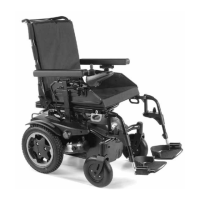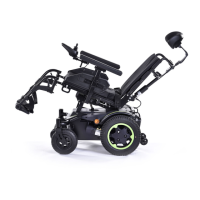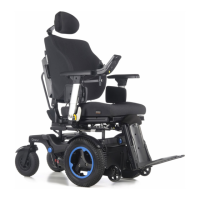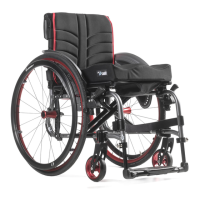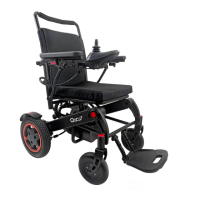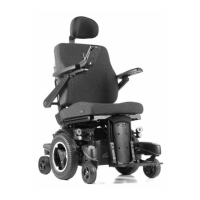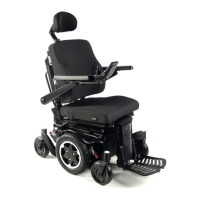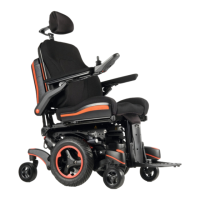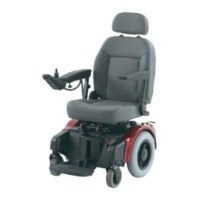
Do you have a question about the Sunrise Medical Quickie RX Kidz and is the answer not in the manual?
| Brand | Sunrise Medical |
|---|---|
| Model | Quickie RX Kidz |
| Category | Wheelchair |
| Language | English |
Guide to understanding the wheelchair's features, usage, maintenance, and care instructions.
Explanation of warning symbols and critical safety precautions for operating the wheelchair.
Details on the wheelchair's purpose, quality standards, and compliance with medical directives.
Provides contact details for Sunrise Medical and local approved dealers for assistance.
Details the warranty coverage for the wheelchair frame and components against defects.
Outlines terms, conditions, and limitations of the manufacturer's warranty for user compliance.
Identifies and labels various parts of the Quickie RX Kidz wheelchair with a detailed diagram.
Covers essential safety advice including anti-tip devices, tyre pressure, and armrest usage.
Guidance on transfers, wheelies, and navigating kerbs, inclines, and obstacles safely.
Step-by-step instructions on how to safely open and fold the Quickie RX Kidz wheelchair.
Advises on how environmental factors affect wheelchair performance and proper drying procedures.
Provides essential instructions for safe assistance during wheelchair use for both rider and attendant.
Explains how the chair's centre of balance affects stability and the risk of tipping.
Discusses elements like body position, surface type, and seating systems that influence balance.
Provides safety tips for dressing or changing clothes while seated to prevent falls or tipping.
Advises on protecting the chair from moisture, rust, and direct sunlight for longevity.
Instructions and warnings for performing wheelies, emphasizing the need for attendant assistance.
Highlights the use of special fasteners and the risks associated with improper tightening or loosening.
Provides advice on clearing doorways and overcoming small obstacles safely, maintaining balance.
Explains how to reach or lean without compromising chair stability to prevent falls.
Guidance on ascending, descending, and maneuvering on inclines, emphasizing speed control and balance.
Detailed instructions and warnings for safely transferring the user into and out of the wheelchair.
Instructions for safely navigating kerbs and single steps, with or without attendant assistance.
Step-by-step guide for attendants assisting the user in descending kerbs or single steps.
Step-by-step guide for attendants assisting the user in ascending kerbs or single steps.
Instructions for attendants to safely move the wheelchair and occupant up or down stairs.
Instructions for attendants to safely lower the wheelchair and occupant down stairs step-by-step.
Instructions for adjusting the footplate height for proper lower leg length and fit.
Describes the benefits of the fixed front end and outrigged frame for stability and performance.
How to adjust seat depth for user growth using extension plugs for increased seating capacity.
Instructions for adjusting the angle and depth of footplates for optimal positioning and comfort.
Details on the function, release, removal, and replacement of swing-away footrests for transfers.
Instructions for installing, adjusting height, and detaching height-adjustable armrests.
Explains how to use and adjust the high mount push-to-lock and knee lever wheel locks for safety.
Information on the different backrest height ranges and the mechanism for adjustment.
Instructions for safely removing and replacing quick-release axles for maintenance or transport.
How to install, secure, and rotate anti-tip tubes for enhanced user safety and stability.
Step-by-step guide to adjusting the footplate height using a screw and specific torque setting.
Adjusting the height of angle-adjustable footplates with precise torque settings for optimal fit.
Instructions for setting the angle and depth of footplates using Allen keys and torque settings.
Guidance for qualified therapists on adjusting upholstery straps for optimal user support.
How to adjust anti-tip tube height using locking pins and multiple hole sets for clearance.
Detailed instructions for adjusting knee lever brakes and wheel locks with specific torque settings.
How to adjust seat height using axle sleeve and plate adjustments with specific torque settings.
Instructions for adjusting standard seat height by moving the axle position in the axle plate.
How to adjust the rear wheelbase by moving the axle sleeve with specified torque settings.
Adjusting the center of gravity by sliding the axle plate with specific torque for stability.
Adjusting standard center of gravity by moving the bracket to a rear position for stability.
How to adjust rear wheel camber by adding or removing camber washers with specified torque.
Instructions for ensuring castor housings are perpendicular to the floor using eccentric bolts.
How to reverse castor assemblies to provide increased footrest clearance.
How to interchange castor wheels and adjust seat height by positioning castor forks.
Instructions for reversing castor assemblies to achieve an inside mount configuration.
How to remove play from the castor stem by tightening the nut for smoother operation.
Instructions for adjusting the tension of the seat sling using Velcro for user comfort.
Details the components of the positioning belt kit and provides instructions for its assembly.
Step-by-step guide on attaching the positioning belt to the wheelchair's back post.
Instructions on securing the belt with cable ties and adjusting it for user comfort and safety.
Guidance for clients on proper lap belt use, daily checks, and maintenance recommendations.
Advice on ensuring the vehicle is equipped for wheelchair transport and safe access procedures.
Guidelines for using compliant tie-down restraints for securing the wheelchair in a vehicle.
Details on using pelvic/torso restraints, head restraints, and leg rests for safe vehicle transport.
Specific instructions for correct positioning and angle for pelvic restraint belts during transport.
Recommended schedule for routine checks of tyre pressure, wheel locks, castors, and fasteners.
Guidance on checking and maintaining spoke tension for wheel integrity and performance.
Instructions for general cleaning of frame and upholstery, avoiding dryers and harsh solvents.
Lists available accessories and necessary tools for wheelchair maintenance and adjustments.
Comprehensive technical specifications including dimensions, weight, stability, and performance data.

